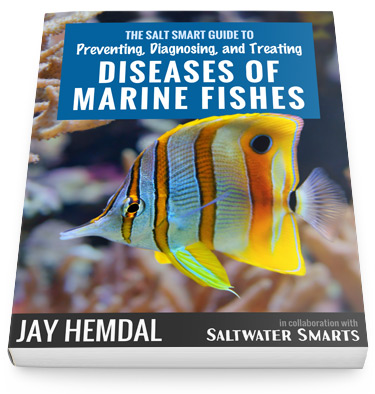Lose “That Sinking Feeling” With Jay Hemdal’s Disease Guide
It’s a sinking feeling for any marine fish keeper—the moment you recognize that a fish in your care is ailing. Perhaps you notice an obvious symptom or behavioral change in the specimen, such as rapid breathing, excessive mucus production, scraping on objects, loss of body mass, a bulging eye (or eyes), the presence of spots, refusing to feed, listlessness, or constantly hiding. Or maybe your experienced eye simply tells you that something about the fish just doesn’t seem quite right, even if you can’t exactly put your finger on it.
When you get “that sinking feeling,” prompt action is very often necessary to prevent the loss of the specimen and, potentially, other fish in the tank. But where to begin? The wrong treatment—or the right treatment misapplied—can do more harm to the fish than the disease itself, so guesswork isn’t a viable option. Nor is it wise to head to your local pet store and pick up the latest “miracle elixir” that claims to cure every piscine malady.
For the sake of your fish, the best course of action is to, first, make as accurate a diagnosis of the disease as possible and, second, implement a proven standard of treatment that’s appropriate for the disease and the species in question. That’s just what The Salt Smart Guide to Preventing, Diagnosing, and Treating Diseases of Marine Fishes will empower you to do.

Written by Jay Hemdal, Curator of Fishes and Invertebrates for the Toledo Zoo and an avid aquarium hobbyist with over 45 years of experience under his belt, The Salt Smart Guide to Preventing, Diagnosing, and Treating Diseases of Marine Fishes provides comprehensive, authoritative, easy-to-comprehend advice on a wide range of fish diseases, such as:
- Marine ich (Cryptocaryon irritans)
- Marine velvet (Amyloodinium)
- Clownfish disease (Brooklynellosis)
- Red-band syndrome (Uronema marinum)
- Bacterial, viral, and fungal diseases
- Exophthalmia (“pop-eye”) and other eye problems
- Husbandry- or environment-related problems, such as Head and Lateral Line Erosion (HLLE)
Each of these sections covers the cause of the disease, symptoms, methods of diagnosis, available treatment options (including authoritative information on medications and dosing), and other information that will help hobbyists arrive at a proper diagnosis and begin the appropriate treatment.
Of course, the very best approach to fish diseases is to prevent them from occurring in the first place. Toward that end, The Salt Smart Guide to Preventing, Diagnosing, and Treating Diseases of Marine Fishes also includes comprehensive advice on selecting healthy specimens, quarantine procedures, acclimation techniques, and the various forms of stress that predispose fish to illness.
In addition, this e-book features a section on zoonosis and dangerous marine organisms as well as a bonus chapter on disease of marine invertebrates. For those who are really determined to get to the bottom of fish losses, Hemdal even walks readers, step by step, through a professional necropsy protocol.
So, whether you currently have a sick fish and want to identify the disease and proper course of action, or you simply want to be better informed about diseases you might encounter in the future, The Salt Smart Guide to Preventing, Diagnosing, and Treating Diseases of Marine Fishes is a vital resource to have at your fingertips.
Learn more about this eBook and buy your copy here: http://www.reef2reef.com/forums/saltwater-smarts/189824-salt-smart-guide-preventing-diagnosing-treating-diseases-marine-fishes.html

Leave a Reply
You must be logged in to post a comment.